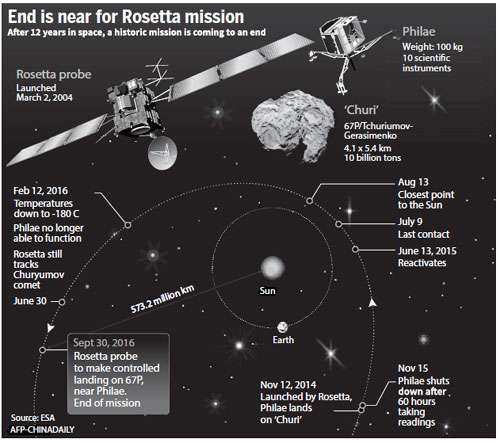Rosetta to give 'final kiss' to comet
Swansong announced as trailblazing space laboratory starts to run low on energy
After nearly two years apart, Europe's Rosetta spacecraft will join stranded robot probe Philae on Sept 30 on the icy surface of a comet hurtling through space, which will be their eternal resting place, mission control said on Thursday.
In orbit around comet 67P/Churyumov-Gerasimenko, which is speeding further and further away from the Sun and its battery-charging rays, the trailblazing space laboratory is starting to run low on energy.
"Rosetta is reaching the end of its natural life," said the European Space Agency, announcing the swansong on a captivating 12-year quest.
"The time has come for the orbiter to join its companion Philae on Churyumov-Gerasimenko," added France's CNES space agency.
After its crashlanding, communications with Rosetta will be severed once and for all, closing the historic mission to unravel the secrets of comets - believed to be time capsules from the birth of the Solar System.
"This announcement may at first si ght appear a little sad, given how people all over the world identified with this remarkable mission," said CNES president Jean-Yves Le Gall.
"But for Rosetta and Philae, it will be a fitting end and the chance to obtain new measurements and close-up pictures of the comet that will yield new data for the world's scientific community."
The data obtained from Rosetta and Philae will continue to be analyzed for months and years to come, with many more discoveries thought possible.
$1.4-billion mission
The $1.4-billion mission, approved in 1993, saw Rosetta launched into space in March 2004, with a comet lander dubbed Philae riding piggyback.
The pair traveled some 6.5 billion kilometers - aided by gravity boosts from Earth and Mars - before entering the comet's orbit in August 2014.
Three months later, Rosetta sent the 100-kilogram Philae probe down to the comet surface, starting a deep-space saga closely watched around the world via cartoon recreations of the pioneering pair.
Philae's nail-biting exploits earned it a loyal Twitter following.
The washing machine-sized robot, with 10 instruments for sniffing and prodding, bounced several times after its harpoons failed to fire into the comet surface.
It ended up in a ditch shadowed from the Sun's battery-replenishing rays, but still managed to run about 60 hours of experiments and send home reams of valuable data before entering standby mode.
As 67P neared the Sun on its elongated orbit, Philae emerged from hibernation in June 2015 and sent a two-minute message via Rosetta, eliciting great excitement on Earth.
But after eight intermittent communications, the lander went permanently silent on July 2015.
Rosetta has continued to probe the comet from a distance, without catching sight of its long-lost charge.
Ground controllers will start changing Rosetta's orbit in August, bringing it progressively nearer the surface.

(China Daily 07/02/2016 page9)














